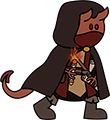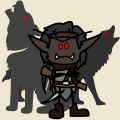Results 91 to 110 of 110
-
2017-06-23, 04:15 PM (ISO 8601)Barbarian in the Playground


- Join Date
- Jan 2011
- Location
- Foggy Droughtland
 Re: Power curves and tiering in leveled RPGs
Re: Power curves and tiering in leveled RPGs
The thing is, if there was a new edition of D&D released (let's call it... 6e) that happened to be "E6, and only E6," it still wouldn't be the only way to play D&D. 3.5 and 4e still exist. Older editions still exist, and OSR and 3.P are things. The whole idea that there's a "one way to D&D," or that only one version of D&D can meaningfully exist at a time, is a canard.
-
2017-06-23, 04:53 PM (ISO 8601)Titan in the Playground


- Join Date
- Oct 2009
- Location
- In my library
 Re: Power curves and tiering in leveled RPGs
Re: Power curves and tiering in leveled RPGs
I'm completely agreeing here. Okay, I actually do occasionally enjoy playing the 'zero' stage, but I still want to advance to 'hero'. If personally rather hang around hero for quite a while, pick up a bunch of contracts, some more skills, a decent but not overly powerful or broad collection of spells/items, a favour or two, maybe even stakes in a company or organisation. But even if I have access to magic I want it to stay at the hero level for a long while.
Because honestly, if I wanted to play a godling (which can be fun) I want to start as one. Mutants and Masterminds terms you that most normal humans are probably level 2-4, maybe as high as 6, and then suggests you begin at level 8 or highest, it makes for a fun game in a way that 'you begin as a level one story with basic abilities' doesn't. A PL10M&M is already a demigod in a way an experienced Victoriana character isn't.
I'm not. I'm just saying that in my view zero to godling is less engaging than hero to hero.
I remember seeing a homebrew that made a bunch classes specifically for E6, each stuff levels long and aiming to represent an archetype. They felt much more satisfying than the basic D&D classes, but that just highlighted how much E6 isn't 'normal' 3.5.
If I had to run D&D 3.5 again, which I don't, it would be E6, but that's because I like the scaling, not because I think it's the only one viable. I just wish 3.X had been able to pick a scale and suck with it (and I personally think 5e has a lesser variety of the problem, although WotC had admitted you're not really supposed to play past level 12 as designed, they focused on where they heard most groups play).
-
2017-06-23, 06:41 PM (ISO 8601)Titan in the Playground


- Join Date
- Jun 2006
- Location
- Poland
- Gender

 Re: Power curves and tiering in leveled RPGs
Re: Power curves and tiering in leveled RPGs
They've actually said that? That's remarkably honest of them. But also entirely unsurprising. Actually making high levels work would require changes to the system 5e wasn't willing to make. Focusing on what the system is... well not good at, but what people expect from it, is perfectly valid. Tacking on 8-10 extra levels just for show, less so.
And I remember the E6-dedicated classes as well. Like I said, the relative popularity of E6 (as an idea, if not in actual play) is very telling.Last edited by Morty; 2017-06-23 at 06:44 PM.


 My FFRP characters. Avatar by Ashen Lilies. Sigatars by Ashen Lilies, Gullara and Purple Eagle.
My FFRP characters. Avatar by Ashen Lilies. Sigatars by Ashen Lilies, Gullara and Purple Eagle.
Interested in the Nexus FFRP setting? See our Discord server.
-
2017-06-23, 10:40 PM (ISO 8601)Barbarian in the Playground


- Join Date
- Apr 2015
 Re: Power curves and tiering in leveled RPGs
There is no reason this is or should be true for what I'm talking about. In a game where capabilities are doled out by level, initial differences can have meaningful consequences down the road, but their relative importance steadily decreases. If you get the ability to kill with fear at level 9, and the ability to teleport and plane shift at level 15, your first level 1d6 fire blast might still have some relevance somehow, but it has steadily decreased and it isn't producing multiplicative complexity.Tiny initial differences between characters are likely to lead to massive and unexpected differences in their middle and end states.
Re: Power curves and tiering in leveled RPGs
There is no reason this is or should be true for what I'm talking about. In a game where capabilities are doled out by level, initial differences can have meaningful consequences down the road, but their relative importance steadily decreases. If you get the ability to kill with fear at level 9, and the ability to teleport and plane shift at level 15, your first level 1d6 fire blast might still have some relevance somehow, but it has steadily decreased and it isn't producing multiplicative complexity.Tiny initial differences between characters are likely to lead to massive and unexpected differences in their middle and end states.
For that matter, just because there are cutoffs when new rules are introduced to abstract and manage issues of scale doesn't mean the bones of the game have now changed. I personally use a set of rules for mass battles in 3.P that abstracts groups of soldiers into mobs and units that behave very much like single monsters. There are differences, but the bones are still the same.
-
2017-06-24, 08:00 AM (ISO 8601)Ettin in the Playground

- Join Date
- Sep 2009
- Gender

 Re: Power curves and tiering in leveled RPGs
Re: Power curves and tiering in leveled RPGs
From a mathematical viewpoint, your statement is false. If you have to add new rules to abstract away information, you are changing the bones of the game. Your swarm of orcs no longer behaves equally compared to if you actually modeled those orcs as individuals.
Similarly, your response to my point about combinational emergence is off base. "1d6 fire damage", "killing with fear" and "teleport" are not equivalent basic elements of a game nor have you provided any set of basic elements from which all of these can emerge. So of course they do not possess the traits which I describe.
Let me be clear: no version of D&D is a good example of what I am talking about, because all versions of D&D cause shifts in play by abritrarily introducing more and different rules. Just because you keep rolling d20 against target numbers isn't a counterargument, because those other rules do not stem or even always rely on d20 rolls."It's the fate of all things under the sky,
to grow old and wither and die."
-
2017-06-24, 07:15 PM (ISO 8601)Barbarian in the Playground


- Join Date
- Jan 2011
- Location
- Foggy Droughtland
-
2017-06-24, 07:21 PM (ISO 8601)Barbarian in the Playground


- Join Date
- Apr 2015
 Re: Power curves and tiering in leveled RPGs
Re: Power curves and tiering in leveled RPGs
I think you're using an arbitrarily narrow definition of "same bones". If you die at 0 hp, resolve tests by rolling 1d20 v. target number, move in an order determined by initiative, have tasks adjudicated by skill bonuses, acquire power by level, only take one class per level, and on and on, the bones remain the same. Now if at 10th level the resolution mechanic suddenly became die pool v. TN and your skill points were jettisoned and you stopped advancing by level and instead bought all of your abilities a'la carte, the system's bones would have changed.
People are claiming this has to be much more complex than it actually does. Spread d20 advancement over 30 levels. Have a subclass that remains constant for each of the three tiers. Refrain from parceling out abilities that provide both lateral and vertical growth in the linear period of each tier--you hit Gimli at 3rd level, and then just become a better version of Gimli for 4 levels after that, before expanding the concept again during the capstone phase of advancement.Last edited by Mendicant; 2017-06-25 at 12:08 AM.
-
2017-06-24, 07:29 PM (ISO 8601)Troll in the Playground


- Join Date
- Mar 2014
-
2017-06-24, 07:41 PM (ISO 8601)Barbarian in the Playground


- Join Date
- Jan 2011
- Location
- Foggy Droughtland
 Re: Power curves and tiering in leveled RPGs
Re: Power curves and tiering in leveled RPGs
I'm mostly talking about spells, yeah.
That said, I feel kind of similarly about everything D&D has that isn't a skill check. I mean, you've got this wonderful universal action resolution mechanic that every character has access to (skills). Then you add attack rolls, which are like skills but aren't for some reason. Then saves, which are like skills but aren't. Then initiative. Couldn't all of these things have just run off of the skill system, instead of creating four different ways to roll a d20 and add numbers to it?
Of course, I'm not actually expecting this to change; I realize attacks, saves, and initiative are more foundational to D&D's traditions than skills themselves are. I still find the half-measures towards a single resolution mechanic funny from a design perspective, though.
-
2017-06-24, 09:52 PM (ISO 8601)Firbolg in the Playground

- Join Date
- Dec 2010
 Re: Power curves and tiering in leveled RPGs
Re: Power curves and tiering in leveled RPGs
Having a single universal resolution mechanic tends to drastically decrease the richness of a game unless you pull off stuff like Frozen_Feet is alluding to and manage to tap into emergence as a source of complexity. Ultimately, there just isn't much you can get out of 'noise + static number, check if > static threshold'.
Last edited by NichG; 2017-06-24 at 09:53 PM.
-
2017-06-25, 06:16 AM (ISO 8601)Titan in the Playground


- Join Date
- Oct 2009
- Location
- In my library
 Re: Power curves and tiering in leveled RPGs
Re: Power curves and tiering in leveled RPGs
a.k.a. 4e with non linear periods at the beginning/end of each tier?
While 4e certainly could have smoothed the transition a bit more I don't really see how this differs from it's Paragon Paths in more than where the start point is.
Well 4e changed everything to (level/2)+stat mod+bonuses, including skills, and just got a +5 bonus, and in 5e everything either doesn't scale or does off of your proficiency bonus. 5e is a single resolution mechanic, I just think it's a bad one.
-
2017-06-25, 10:46 AM (ISO 8601)Barbarian in the Playground


- Join Date
- Apr 2015
 Re: Power curves and tiering in leveled RPGs
Re: Power curves and tiering in leveled RPGs
This idea is explicitly based off the 4e tiers, yes. However, 4e's progression was *too* smooth, and class design was too samey both across classes and across levels. 3.x is more robust as a system and would provide more of the core rules and overall power scale.
Imagine getting power along the lines of 1st and 2nd level spells at 1st-3rd, along with some other key class features, then most of your advancement from 4th-7th level comes in the form of scaling bonuses to things you already do: sneak attack dice, caster level, bardic music bonuses, maybe some metamagic. At 8th-10th you break open the equivalent of 3rd and 4th level magic.
You'd need to organize casting a bit differently--maybe you get 5e-style cantrips and a few new "least spells/invocations" at 1st, 2nd and 3rd level, and then at 8th you get "lesser spells" and at tenth you get your first "greater spell".
-
2017-06-25, 11:46 AM (ISO 8601)Titan in the Playground


- Join Date
- Oct 2009
- Location
- In my library
 Re: Power curves and tiering in leveled RPGs
Re: Power curves and tiering in leveled RPGs
Honestly, I'd just be running Victoriana instead. Magic didn't get to insane power without plot (and you just know I'll have a powerful ritual or three appear in the campaign), and players also get to play around with technology. If I'm running a game focused on 1st-3rd level spells for that long I likely don't want higher magic (personal preference).
I thought 4e only really succeed in being what it should haven been in the Paragon tier. Paragon Paths were awesome in a way most Epic Destinies weren't, and chargers in the heroic tier were generally boring. Although I've become very interested in Essentials as an alternative version of 4e.
-
2017-06-25, 03:28 PM (ISO 8601)Barbarian in the Playground


- Join Date
- Jan 2011
- Location
- Foggy Droughtland
-
2017-06-25, 04:28 PM (ISO 8601)Ettin in the Playground


- Join Date
- Sep 2011
- Location
- Calgary, AB
- Gender

-
2017-06-25, 07:42 PM (ISO 8601)Firbolg in the Playground

- Join Date
- Dec 2010
 Re: Power curves and tiering in leveled RPGs
Re: Power curves and tiering in leveled RPGs
Well as I said, if you can get some emergence going a single mechanic can be very deep. But focusing on the 'resolution' part of that pays attention to the wrong part.
If anything, if you want emergent complexity you almost need an 'un-resolution' mechanic - something that asks two questions for every one answer it gives. That's how complexity builds rather than shrinks.
-
2017-06-26, 09:18 PM (ISO 8601)Troll in the Playground

- Join Date
- Mar 2015
 Re: Power curves and tiering in leveled RPGs
Re: Power curves and tiering in leveled RPGs
I sort of understand what you mean, but at the same if it is always increasing complexity how do you finish the scene?
-
2017-06-27, 04:43 AM (ISO 8601)Firbolg in the Playground

- Join Date
- Dec 2010
 Re: Power curves and tiering in leveled RPGs
Re: Power curves and tiering in leveled RPGs
Last edited by NichG; 2017-06-27 at 04:44 AM.
-
2017-06-27, 08:36 AM (ISO 8601)Titan in the Playground


- Join Date
- May 2016
- Location
- The Lakes
 Re: Power curves and tiering in leveled RPGs
It is one thing to suspend your disbelief. It is another thing entirely to hang it by the neck until dead.
Re: Power curves and tiering in leveled RPGs
It is one thing to suspend your disbelief. It is another thing entirely to hang it by the neck until dead.
Verisimilitude -- n, the appearance or semblance of truth, likelihood, or probability.
The concern is not realism in speculative fiction, but rather the sense that a setting or story could be real, fostered by internal consistency and coherence.
The Worldbuilding Forum -- where realities are born.
-
2017-06-27, 09:24 AM (ISO 8601)Firbolg in the Playground

- Join Date
- Dec 2010
 Re: Power curves and tiering in leveled RPGs
Re: Power curves and tiering in leveled RPGs
Richness and complexity come from extended interactions, so if your only mechanic is something which compartmentalizes things and removes them from play then it's not very good for creating those interactions. If you have a mechanic where you can succeed or fail at climbing a wall during your turn and then it's done either way, that leaves fewer hooks to tie interactions to than if you had a mechanic where for example you could end up paying different resource costs to climb that wall, or where climbing the wall made that area permanently more/less passable, or where climbing the wall created a temporary opportunity for enemies to take action for a period of time during the climb, or...





 Reply With Quote
Reply With Quote ) by Honest Tiefling.
) by Honest Tiefling.




 RSS Feeds:
RSS Feeds: 

